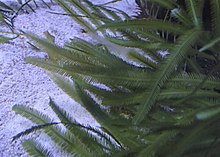Loading AI tools
Species of alga From Wikipedia, the free encyclopedia
Caulerpa taxifolia is a species of green seaweed, an alga of the genus Caulerpa, native to tropical waters of the Pacific Ocean, Indian Ocean, and Caribbean Sea.[2] The species name taxifolia arises from the resemblance of its leaf-like fronds[3] to those of the yew (Taxus). [citation needed]
| Caulerpa taxifolia | |
|---|---|
 | |
| Scientific classification | |
| Clade: | Viridiplantae |
| Division: | Chlorophyta |
| Class: | UTC clade |
| Order: | Bryopsidales |
| Family: | Caulerpaceae |
| Genus: | Caulerpa |
| Species: | C. taxifolia |
| Binomial name | |
| Caulerpa taxifolia (M.Vahl) C.Agardh, 1817[1] | |
A strain of the species bred for use in aquariums has established non-native populations in waters of the Mediterranean Sea, the United States, and Australia.[4] It is one of two species of algae listed in 100 of the World's Worst Invasive Alien Species compiled by the IUCN Invasive Species Specialist Group.[5]

C. taxifolia is light green[3] with stolons (stems) on the sea floor, from which sparsely-branched upright fronds of approximately 20–60 cm (8–24 in) in height arise.[6] Algae in the genus Caulerpa synthesize a mixture of toxins[7] termed caulerpicin, believed to impart a peppery taste to the plants.[8] The effects of the specific toxin synthesized by C. taxifolia, caulerpenyne, have been studied,[9][10] with extracts from C. taxifolia being found to negatively affect P-glycoprotein-ATPase in the sea sponge G. cydonium.[11]
Like all members of the genus Caulerpa, C. taxifolia consists of a single cell with many nuclei. The algae has been identified as the largest known single-celled organism.[12] Wild-type C. taxifolia is monoecious.[13]
Caulerpa species are commonly used in aquaria for their aesthetic qualities and ability to control the growth of undesired species.[14] C. taxifolia has been cultivated for use in aquaria in western Europe since the early 1970s.[15] A clone of the alga that was resistant to cold was observed in the tropical aquarium at the Wilhelma Zoo in Stuttgart[16] and further bred by exposure to chemicals and ultraviolet light.[17] The zoo distributed the strain to other aquaria, including the Oceanographic Museum of Monaco.[16]
The aquarium strain is morphologically identical to native populations of the species.[3] However, a 2008 study found that a population of the aquarium strain near Caloundra, Australia exhibited markedly reduced sexual reproduction, with only male plants present during some reproductive episodes.[13] The aquarium strain can survive out of water for up to 10 days in moist conditions, with 1 cm fragments capable of producing viable plants.[18]
Outside its native range, C. taxifolia is listed as an invasive species.[19][20] It is one of two algae on the list of the world's 100 worst invasive species compiled by the IUCN Invasive Species Specialist Group.[5] The species is able to thrive in heavily polluted waters,[21] possibly contributing to its spread in the Mediterranean.[22]
The presence of C. taxifolia in the Mediterranean was first reported in 1984[23] in an area adjacent to the Oceanographic Museum of Monaco.[24] Alexandre Meinesz, a marine biologist, attempted to alert Moroccan and French authorities to the spread of the strain in 1989,[16] but the governments failed to respond to his concerns.[25] The occurrence of the strain is generally believed to be due to an accidental release by the museum,[3][26] but Monaco rejected the attribution and instead claimed that the observed algae was a mutant strain of C. mexicana.[25] By 1999, scientists agreed that it was no longer possible to eliminate the presence of C. taxifolia in the Mediterranean.[25]
A study published in 2002 found that beds of Posidonia oceanica in the Bay of Menton were not negatively affected eight years after colonization by C. taxifolia.[27] Other published studies have shown that fish diversity and biomass are equal or greater in Caulerpa meadows than in seagrass beds[28] and that Caulerpa had no effect on composition or richness of fish species.[29]
Studies in 1998[15] and 2001[23] found that the strain observed in the Mediterranean was genetically identical to aquarium strains, with similarities to an additional population in Australia.
A 2007 study found that a native bivalve mollusc species was negatively affected by the presence of C. taxifolia, but that the effect was not necessarily different from that of native seagrass species.[30] A 2010 study indicated that the effect of detritus from C. taxifolia negatively impacted abundance and species richness.[31]
C. taxifolia was found in waters near San Diego, California, in 2000,[32] where chlorine bleach was used in efforts to eradicate the strain.[33] The strain was declared eradicated from Agua Hedionda Lagoon in 2006.[34] California passed a law in 2001 forbidding the possession, sale, transport, or release of Caulerpa taxifolia within the state.[35] The Mediterranean clone of C. taxifolia was listed as a noxious weed in 1999[36] by the Animal and Plant Health Inspection Service, prohibiting interstate sale and transport of the strain without a permit under the Noxious Weed Act and Plant Protection Act.[24][37]
C. taxifolia may become entangled in fishing gear and boat propellers.[4]
C. taxifolia may be controlled via mechanical removal, poisoning with chlorine, or application of salt.[6] Researchers at the University of Nice investigated possible use of a species of sea slug, Elysia subornata, as a possible natural control method, but found that it was not suitable for use in the Mediterranean due to cold winter water temperatures and insufficient population density.[38]
Seamless Wikipedia browsing. On steroids.
Every time you click a link to Wikipedia, Wiktionary or Wikiquote in your browser's search results, it will show the modern Wikiwand interface.
Wikiwand extension is a five stars, simple, with minimum permission required to keep your browsing private, safe and transparent.